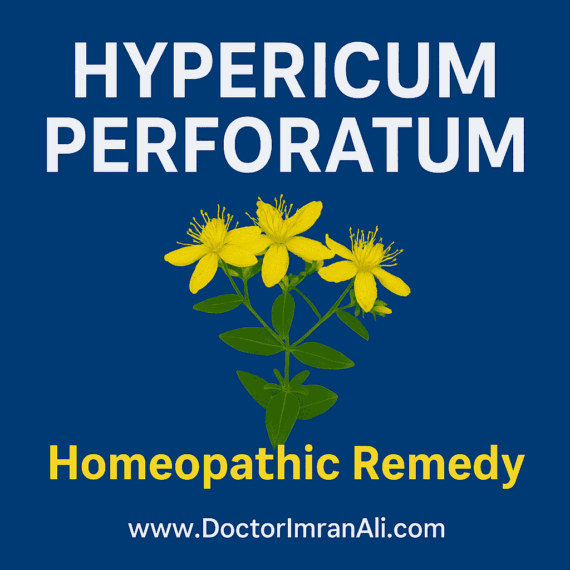Materia Medica of Hypericum Perforatum
Today I’ll be discussing the Materia Medica of Hypericum Perforatum, derived from a plant commonly known as St. John’s Wort. The potentized version of this substance is simply referred to as Hypericum. Botanically, it is classified as a member of the Hypericaceae family, formerly considered a subfamily of the Clusiaceae family.
Hypericum is a commonly indicated remedy used mostly for acute conditions and has a relatively narrow therapeutic range of action.

Summary and Keynote of Hypericum Perforatum
Hypericum is primarily a remedy for nerve pains and nerve-related symptoms caused by nerve injuries — especially puncture wounds. It is the first remedy to think of when a condition involves injury to the nerves.
Hypericum Has Affinity For Nerve-Rich Areas of the Body
The highest concentrations of nerve endings are found at the:
- Fingertips
- Face and lips
- Hands and palms
- Feet and soles
- Genitalia (male and female)
The head, neck, and spine contain many nerves protected by bone but remain vulnerable to injury — especially the neck, sacrum, and tailbone (coccyx). Injuries to these areas can cause severe pain.
Two nerves are particularly prone to trauma:
- Sciatic nerve — running from the lower back through the legs to the heel.
- Ulnar nerve — extending from the elbow to the hand, commonly injured at the “funny bone.”
Nature of Pain and Symptoms of Hypericum
Hypericum pains are typically:
- Sharp, darting, shooting, and neuralgic
- Violent and severe
- Travel along the course of a nerve
- Worsen after injury to nerve-rich areas such as fingers, toes, or spine
Other possible symptoms include:
- Tingling, crawling sensations, and numbness
- Jerking, twitching, spasms, or convulsions
- Weakness or even paralysis
- Burning sensations or inflammation (Read Belladonna & inflammation)
Three Factors To Consider When Prescribig Hypericum
Consider Hypericum when these three factors are present together:
- Injury — as the main cause
- Involvement of nerves or nerve-rich areas
- Nerve-related symptoms such as sharp or shooting pains
Mental and Emotional Symptoms of Hypericum
Although St. John’s Wort is known as an herbal treatment for mild depression, homeopathic Hypericum is not typically prescribed for that reason. It is used when mental symptoms follow injury or surgery.
Possible mental symptoms include:
- Depression, melancholy, or weepiness
- Mental dullness, forgetfulness, or poor memory after head/spinal injury
- Mistakes in speaking or writing (e.g., saying “right” instead of “left”)
- Delusion of floating in the air with fear of falling (often after head injury)
General Characteristics of Hypericum Perforatum
General traits of Hypericum patients may include:
- Desire for wine, pickles, and warm food or drinks
- Aggravation from cold
Modalities
Worse from:
- Cold, damp, fog, or change of weather
- Touch, pressure, or exertion
Better from: lying quietly
Clinical Applications of Hypericum
Hypericum can be indicated in many types of injuries and trauma to nerves, including:
Head, Neck, and Spine Injuries
- Whiplash with stiff neck and shooting pain
- Head injuries, concussions, and spinal cord injuries
- Convulsions or spasms following trauma
Tailbone Injuries
Almost a specific remedy for coccyx and sacrum injuries. Severe tailbone pain after a fall or during childbirth often responds dramatically to Hypericum.
Nerve and Limb Trauma
- Injury to the ulnar nerve (“funny bone”)
- Phantom limb pain after amputation
- Post-surgical nerve pain, including dental extractions or root canals
Other Indications
- Facial paralysis in infants after forceps delivery
- Eye injuries involving the eyeball
- Old painful scars (cicatrix)
- Burns over nerve-rich areas
Use of Hypericum In Punctured Wounds
Hypericum and Ledum are the main remedies for puncture wounds.
Unintentional Puncture Wounds
- Stepping on nails or deep splinters
- Knife or gunshot wounds
- Animal bites or insect stings
When such wounds produce sharp, shooting pains or extreme tenderness, Hypericum is the first choice. It helps prevent infection and tetanus (lockjaw).
Medical Puncture Wounds
- Dental anesthesia injections
- Spinal taps (lumbar puncture)
- Nerve blocks, spinal anesthesia, epidurals
Hypericum can help when such procedures injure sensitive spinal or peripheral nerves. In some cases, it has even improved symptoms resembling multiple sclerosis after nerve trauma.
Other Indications of Hypericum
- Sciatica following injury
- Toothache better by lying quietly on affected side
- Hemorrhoids with back pain
- Vertigo with floating sensation, worse on urination
- Asthma following spinal injury, worse in fog or cold damp weather
Remedy Relationships
- Arnica: injuries to soft tissues (compare with Hypericum for nerve injuries)
- Ledum: puncture wounds, better from cold (opposite of Hypericum)
- Natrum Sulphuricum: head, neck, and spine injuries
- Staphysagria: painful scars, surgical incisions, phantom limb pain
- Allium cepa: phantom limb pain
- Calendula: general wounds and skin injuries
That concludes the discussion of Hypericum Perforatum — a vital remedy for nerve-related injuries and puncture wounds.
We Provide Online Homeopathic Consultation:
If you need homeopathic consultation follow these 2 simple steps. 1- Pay Consultation Fee 2- Submit your Case – We will get back to you ASAP and proceed further.